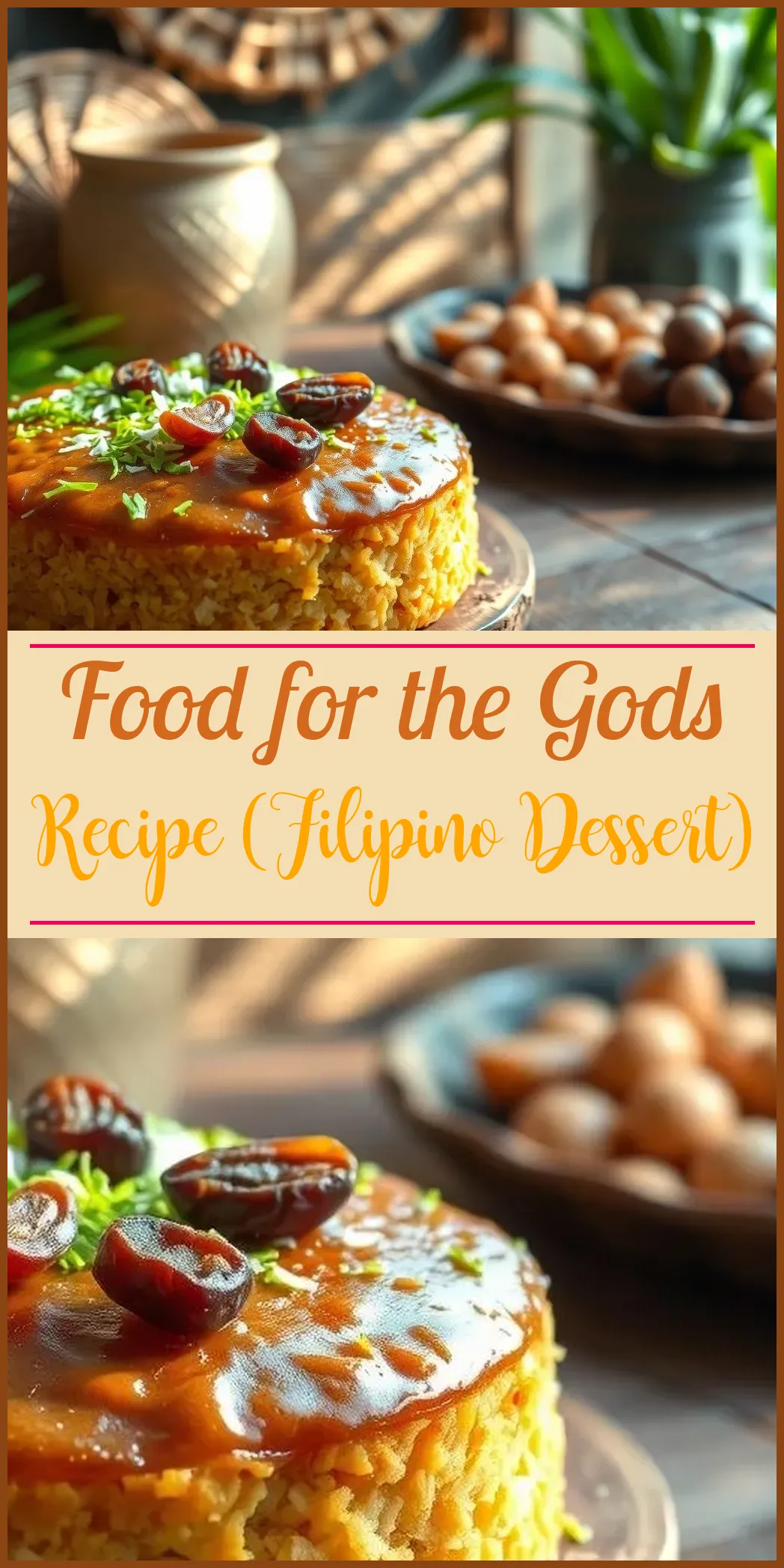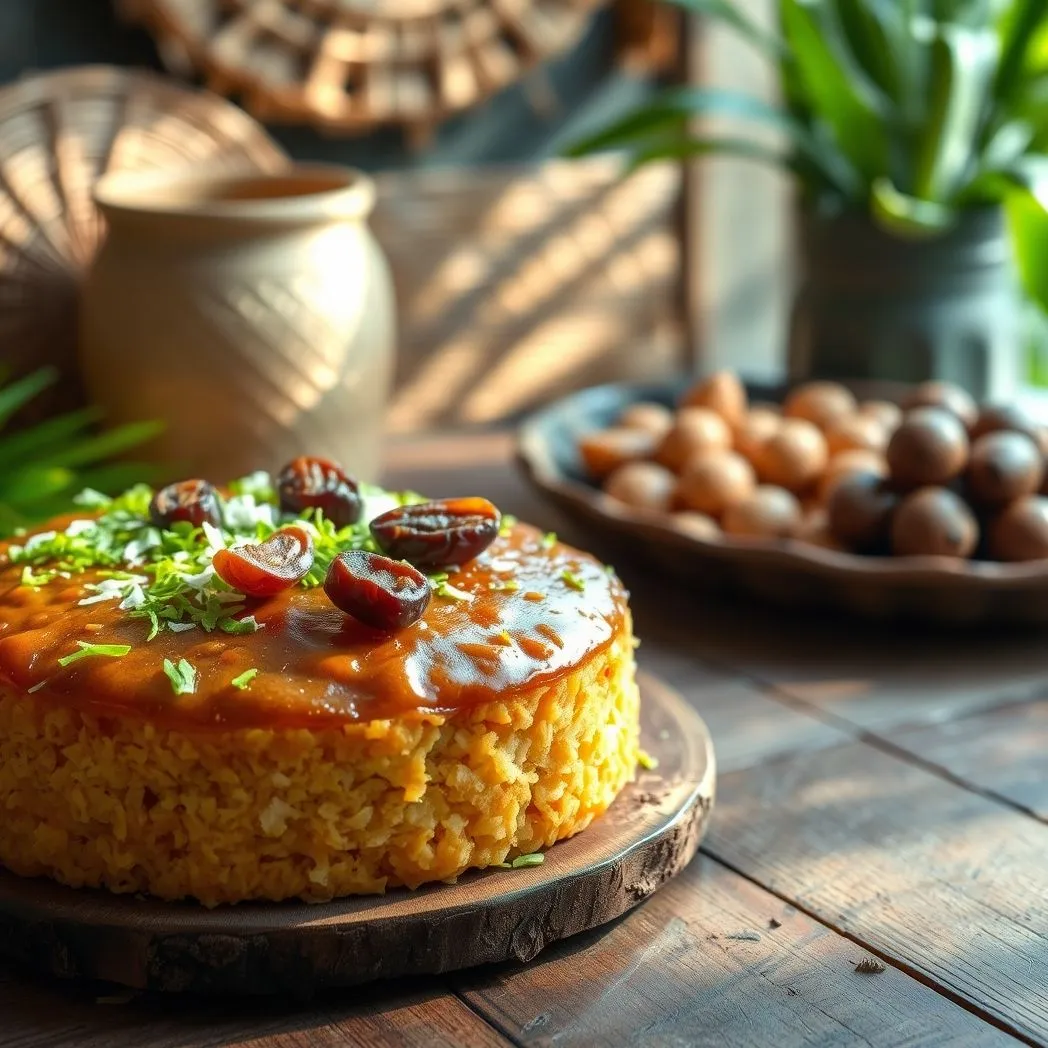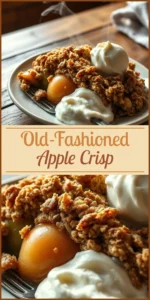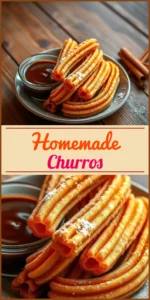Experience a classic Filipino dessert that has delighted generations. Food for the Gods is a delectable blondie with a butterscotch flavor, enhanced by chewy dates and crunchy walnuts. This dessert embodies comfort and luxury with every bite. In this article, you will learn everything about this delicious treat—from its origins to step-by-step instructions and helpful tips.
What Is Food for the Gods?
Food for the Gods is a Filipino dessert that marries a rich, buttery blondie base with the sweet tang of butterscotch. The recipe features dried dates and walnuts, which add texture and depth. You might compare it to blondies or even fruitcakes, but with unique Filipino ingredients and flavors. Historically, dates and walnuts were considered luxury ingredients in the Philippines, making this dessert a symbol of opulence.
This dessert is notably popular during the holiday season. However, its popularity extends beyond festive times. Many enjoy it any day of the year because it is easy to make and satisfying to eat. The balance of moist, chewy texture with a slight crunch makes this treat a favorite among dessert enthusiasts.

Historical Roots and Cultural Significance
Filipino cuisine weaves together many influences, and Food for the Gods reflects this heritage. Its simple ingredients tell stories of abundance and celebration. Traditionally served during Christmas—an event that in the Philippines is celebrated for several months—this dessert was prized because of the rarity of its components in earlier times.
The name “Food for the Gods” hints at its esteemed status. It evokes myth and legend, suggesting that the dessert is fit for divine beings. Today, it continues to be an integral part of Christmas gatherings and family celebrations.
Essential Ingredients and Their Roles
The recipe relies on basic ingredients, each contributing to the final taste and texture. Here are the key components:
-
Flour
All-purpose flour serves as the structural base. A kitchen scale helps achieve precise measurements. -
Baking Powder & Baking Soda
These leavening agents help the batter rise and create the desired texture. -
Salt
A pinch of salt heightens the sweetness by providing contrast. -
Dates
Use dried, pitted dates for their natural sweetness and chewy consistency. Coating them with flour before chopping prevents them from sticking. -
Butter
Unsalted butter adds richness. If salted butter is used, adjust the salt accordingly. -
White and Brown Sugar
White sugar lends sweetness, while brown sugar contributes moisture and a chewy texture. Some variations use muscovado sugar for an extra touch of caramel flavor. -
Eggs
Eggs enrich the batter and help bind the ingredients together. -
Walnuts
Chopped walnuts offer crunch as well as an earthy flavor that balances the sweetness.
Each ingredient combines to create a dessert that is both comforting and indulgent. Using quality, room-temperature ingredients ensures the best results.
Step-by-Step Instructions
Follow these clear and concise steps to achieve a perfect batch of Food for the Gods:
1. Preparation
-
Preheat the Oven:
Set your oven to 350°F (175°C). A preheated oven ensures even baking. -
Prepare the Pan:
Grease your baking pan with butter or non-stick spray. The ample butter in the recipe will help prevent sticking, so parchment paper is optional.
2. Chopping Dates and Walnuts
- Coat and Chop:
Dust the pitted dates lightly with a portion of the flour. This prevents them from clumping.
Roughly chop the dates and walnuts into bite-sized pieces. Avoid chopping them too fine; texture is key.
3. Mixing Dry Ingredients
- Sift Together:
Sift all-purpose flour, baking powder, baking soda, and salt into a bowl. This ensures a smooth mixture free of lumps. Sifting also aerates the ingredients, contributing to a lighter texture.
4. Combining the Wet Ingredients
- Cream Butter and Sugars:
In a large bowl, beat the softened butter with white and brown sugars until the mixture is smooth. - Add Eggs:
Incorporate eggs gradually, stirring well after each addition to form a uniform mixture.
5. Bringing It All Together
-
Merge Mixtures:
Slowly fold the dry ingredients into the wet mixture using a rubber spatula.
Scrape the sides and bottom of the bowl to capture every bit of batter. -
Avoid Overmixing:
Once the flour is incorporated, stop stirring. Overmixing can make the bars tough. Fold in the dates and walnuts gently to distribute them evenly.
6. Baking Process
- Initial Baking:
Place the batter in the prepared pan. Bake at 350°F for about 10 minutes. This initial phase sets the structure. - Lowering the Temperature:
Reduce the heat to 300°F (150°C) and continue baking for 30 to 40 minutes. This slow bake allows the flavors to meld, and the dessert achieves its characteristic chewiness. - Cooling:
Remove the pan from the oven and let the dessert cool completely. Cooling is essential to firm up the bars and prevent crumbling when cutting.
7. Serving
- Slice and Enjoy:
Once fully cooled, slice the dessert into squares. Given its rich texture, these bars pair beautifully with coffee or tea. They also serve as an indulgent treat atop a scoop of vanilla ice cream.
Helpful Tips and Tricks
To perfect your Food for the Gods, consider the following suggestions:
-
Uniform Ingredient Temperature:
Use room-temperature butter and eggs. This allows for even mixing and prevents the batter from separating. -
Chopping Dates and Walnuts:
For non-clumping dates, coat them lightly with flour before chopping. A light hand with a knife or food processor works well. -
Sugar Variations:
Experiment with dark brown sugar or muscovado sugar. The extra molasses in these sugars can enhance the chewiness and caramel notes while giving the bars a slightly darker hue. -
Striking the Right Balance:
Overmixing is a common pitfall. Mix until the flour disappears, then fold in dates and walnuts. Resist the urge to stir continuously. -
Under-Baking for Chewiness:
Similar to fudge brownies, a slight underbake will yield a chewy, moist texture. Check by inserting a toothpick; it should come out with a few moist crumbs, not completely clean. -
Cooling and Cutting:
Allow the bars to cool completely to avoid disintegration. For neat slices, use a sharp knife that you dip in warm water periodically.
Storage and Restoring Freshness
Proper storage can extend the life of your dessert. Here’s how to keep it fresh:
-
Room Temperature:
Store Food for the Gods in an airtight container on the countertop for up to three days. Ensure the container seals tightly to maintain moisture. -
Refrigeration:
If you need a longer shelf life, refrigerate the bars. They stay fresh for up to one week in the fridge. Let them come to room temperature before serving for the best taste. -
Freezing Ahead:
For extended preservation, freeze the dessert. Wrap each square in plastic wrap, then store in a freezer-safe bag. Freeze for up to a week. Thaw overnight in the refrigerator before consumption.
Serving Variations and Pairing Ideas
Food for the Gods is versatile in both flavor and presentation. Here are some serving ideas:
-
Casual Brunch:
Serve a square alongside hot coffee. The slightly bitter brew contrasts the dessert’s sweetness. -
Holiday Gatherings:
Arrange an assortment of slices on a festive platter. They make a delightful addition to any holiday food spread. -
Gourmet Twist:
Top each square with a light dusting of powdered sugar or a drizzle of caramel sauce. A scoop of ice cream or a dollop of whipped cream adds an extra layer of decadence. -
Textural Contrast:
Pair these bars with a side of fresh fruits. Citrus fruits, such as orange segments, brighten the rich flavors of the dessert.
Exploring Variations in Recipe
While the traditional Food for the Gods recipe remains a favorite, small adjustments can personalize this dessert. Experiment with these variations:
-
Nut Substitutions:
Swap walnuts for pecans or almonds if desired. Different nuts introduce a unique flavor profile to each batch. -
Dried Fruit Options:
Change up the dried fruits by using figs or apricots. Each fruit offers a distinct sweetness and chewiness. -
Spice Infusions:
Add a dash of cinnamon or nutmeg for a warm, aromatic twist. These spices complement the butterscotch flavor without overpowering it. -
Gluten-Free Adaptation:
For gluten-free options, substitute all-purpose flour with a blend of gluten-free flours. Ensure the blend contains a binder like xanthan gum to maintain the dessert’s texture.
The Joy of Making and Sharing
Food for the Gods is more than just a dessert—it is a celebration of heritage and simple ingredients. Preparing it can become a family ritual, connecting generations through shared tradition. When you bake these bars, think of it as crafting a slice of history that combines creativity with culinary precision.
Using everyday pantry items, you create something extraordinary that pays homage to Filipino culture. Sharing these desserts can spark conversations about traditions, memories, and personal twists on the classic recipe. Whether enjoyed on a quiet afternoon or served at a big holiday gathering, every bite carries a rich narrative of flavor and festivity.
Concluding Thoughts
Food for the Gods stands as a testament to Filipino ingenuity in the kitchen. With its delightful blend of butter, sugar, dates, and walnuts, every square offers a perfect balance of flavors and textures. Clear instructions, practical tips, and serving ideas make this recipe approachable and inviting for both novice bakers and seasoned cooks.
This dessert is crafted with passion and centuries of cultural influence. Each step—from mixing and baking to cooling and serving—enriches the experience. By making Food for the Gods, you are not only creating a sweet treat but also celebrating the beauty of Filipino culinary traditions.
Enjoy this dessert as a daily indulgence or as a festive centerpiece. Experiment with different ingredients to make the recipe truly your own. Above all, savor every moment spent in the kitchen and every bite that carries the legacy of a timeless dessert.
Embrace the mythology and joy behind each square. Let Food for the Gods inspire your creativity and connect you with family and friends through shared taste and tradition.
Bon appétit!

Food for the Gods Recipe (Filipino Dessert)
With a name like “Food for the Gods,” you know this dessert recipe will be good! These gooey blondie bars are filled with dates and walnuts. They do not disappoint.
Ingredients
- 1 cup dates, pitted and chopped
- 3 large eggs
- 1/4 teaspoon salt
- 3/4 cup granulated sugar
- 3/4 cup packed dark brown sugar
- 3/4 cup unsalted butter, softened
- 1 cup chopped walnuts
- 1/2 teaspoon baking powder
- 1/2 teaspoon baking soda
- 1 1/4 cups sifted all-purpose flour
Instructions
- Preheat the oven to 350 degrees Fahrenheit. Grease a 9x13-inch baking pan. Use non-stick spray.
- Sift flour, baking powder, baking soda, and salt into a bowl. Set the bowl aside.
- Add butter and sugars to a large bowl. Beat them together with an electric mixer until light and fluffy. Add the eggs, one by one. Beat well after each addition.
- Mix the flour mixture with a rubber spatula. Continue until there are no more streaks of flour. Stir in the dates and walnuts.
- Pour the batter into the prepared pan. Bake for 10 minutes at 350 degrees Fahrenheit. Then, reduce the heat to 300 degrees. Continue baking for 30 to 40 minutes more.
- Let cool on a wire rack for 20 minutes. Slice into squares. Serve. Enjoy!




